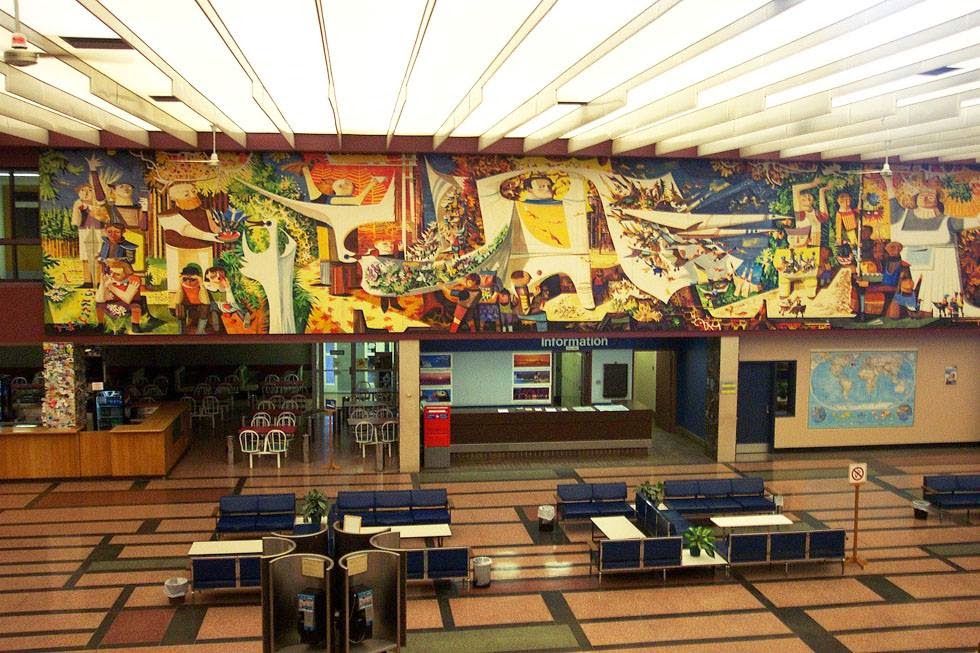We called the evening drinks the Night Stages and found that powerfully amusing...(T)he race was divided into eight stages. “A series of punishing distances,” he said. “Like stations of the cross.” The nightly sessions in the bar were an antidote of sorts to the day's suffering and, he added, an acknowledgement of more to come.
Tamara – a British woman from a priviledged background who spent WWII ferrying fighter planes to the various runways where they were needed for missions – is running away from an unhappy love affair a decade after the war. Fogbound while refuelling in Gander, she is forced to spend three days in the airport, studying the Lochhead mural and recalling the events that had led her here. In a separate storyline, we follow Kenneth Lochhead as he learns the art of painting murals, ending with his completion of the Gander commission. In the most exciting and emotional plotline, we learn of the childhood, coming of age, and bike training of Tamara's lover's younger brother, Kieran. While Tamara might be considered the main character of the book, it's Kieran who stands out as the most fully realised character, and as these two never actually meet, I had a vague feeling of dissatisfaction when the book was done.
And yet...Jane Urquhart is a beautiful writer, and as she has shown before, she has a rare gift for translating the geography and weather and atmosphere of place – and perhaps especially of Ireland – onto the page. Line by line, this was a lovely read, and I would have been totally satisfied if this book had focussed on Kieran alone. His experiences were heartbreaking but believable, I adored his relationship with substitute mother Gerrie-Annie, his was the only love story I felt engaged in, and the facts and metaphors of his bike training – even the overwrought presence of his Miyagi-like cycling coach (who turns out to have been a real person with no connection to cycling; poet Michael Kirby) – I found his whole story to be completely compelling. And the bike race itself was exciting, bordering on the mythic:
It was said that there was a dark blood feud between the brothers of each generation of the Cahersiveen Riordans going back to Norman times, when one member of the tribe had betrayed another in battle. It was also said that there was traveller blood in the family, and it was this that caused the youngest boy in each generation to “go wild”, to run away to the mountains as soon as he could walk to be suckled by feral goats. It was said that the blood feud would, in each generation, be played out by a test of skills, a fiddling or piping contest during famine times when the men would have been weak from hunger, but most often by a sporting event; foot races, hurling or Gaelic football.I did like Lochhead's story and was interested in the journey that led to him finding his own artistic vision (and apparently he was a real life friend 0f Urquhart's husband, so it may not all be conjecture). I had never heard of this mural and its inclusion is definitely timely: within only two years of painting Flight and its Allegories, transatlantic flights no longer needed to stop in Gander for refuelling and artwork that was meant to greet millions has been seen by a small fraction of that number. Long underused, “the single most important modernist room in Canada” has become endangered. But as interesting as I found it, and as worthy as the subject matter might be for its own book, these sections of The Night Stages just didn't relate to the rest. Also, I couldn't quite get a handle on Tamara – this former pilot and independent thinker who eventually allowed her life to be ruled by less than satisfactory romantic entanglements. I suppose she's present to link the bike race with the mural, to interpret elements of the painting and to draw conclusions that have a larger meaning to the overall themes of the book:
She looks at the mural, moving her head from left to right, taking in the full brunt of it in the rich, low morning light. She allows its chaos and its odd calm to enter her mind. Some of the figures are so emplaced they seemed to be wholly defined by the act of absolute arrival. Others are caught in the process of moving away. And far back in the trees, rendered in shades of grey, one or two appear to be poised on the edge of full disappearance.These three storylines could have made for three interesting books, but put together, they just don't seem to mesh. I did enjoy the journey, learned many interesting things, but am left scratching my head. (And yes, I do get how that's very much the same response I have while looking at Lochhead's mural; and yes, that might be the point.)


